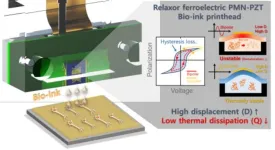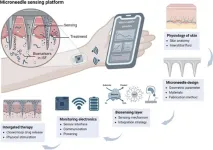(Press-News.org) Boston, Massachusetts, 12 November 2024 – Environmental exposure to air pollutants during critical developmental periods may significantly impact autism risk, according to a groundbreaking Emerging Topic review published 12 November 2024, in Brain Medicine. The study reveals how common air pollutants, including fine particulate matter and nitrogen oxides, can trigger complex biological cascades affecting brain development.
"Different kinds of neurological disorders, including autism spectrum disorder, can be associated with this environmental factor," explains Professor Haitham Amal from the Hebrew University of Jerusalem, the study's senior author. "The timing of exposure appears crucial, with heightened vulnerability during prenatal development and early childhood when critical neurodevelopmental processes occur."
The review identifies several key pathways through which air pollutants may influence ASD development:
• Nitrosative stress orchestrated by nitric oxide (NO)
• Neuroinflammation and oxidative stress
• Disruption of neurotransmitter systems
• Epigenetic modifications
• Endocrine system interference
• Metabolic pathway dysregulation
Of particular concern is the finding that smaller particles, especially PM2.5 as well as NO products, can cross the placenta and affect fetal brain development. This revelation raises important questions about protective measures for pregnant women in highly polluted areas.
"The research suggests that individuals with genetic predisposition to ASD may be more vulnerable to the harmful effects of air pollution exposure," Professor Amal notes. "This interaction between genetic and environmental factors opens new avenues for understanding ASD's complex etiology."
“My lab has shown that NO plays a major role in ASD. However, this study emphasizes the critical role of this molecule and its derivatives on the brain” Prof. Amal comments.
The review, first authored by PhD student Shashank Ojha, also highlights promising directions for biomarker development, potentially enabling early identification of at-risk individuals. These findings arrive at a crucial time, as global ASD prevalence reaches 1-1.5% of the population.
The implications extend beyond individual health to public policy. How might cities need to adapt their urban planning to protect vulnerable populations? What role could air quality monitoring play in prenatal care? These questions become increasingly urgent as urbanization continues worldwide.
The research team emphasizes the need for comprehensive studies examining the combined effects of multiple pollutants, particularly during specific developmental windows. Understanding these interactions could prove crucial for developing effective preventive strategies.
The Emerging Topic review, titled “Air Pollution: An Emerging Risk Factor for Autism Spectrum Disorder,” will be published in Brain Medicine on November 12, 2024. It will be freely available online at https://url.genomicpress.com/2p8wcjw3.
About Brain Medicine: Brain Medicine (ISSN: 2997-2639) is a peer-reviewed journal published by Genomic Press, New York. Brain Medicine is a new home for the cross-disciplinary pathway from innovation in fundamental neuroscience to translational initiatives in brain medicine. The journal’s scope includes the underlying science, causes, outcomes, treatments, and societal impact of brain disorders, across all clinical disciplines and their interface.
END
Air pollution emerges as critical environmental risk factor for autism, emerging topic review finds
Scientists reveal complex links between air pollutants and neurodevelopmental disorders in landmark brain medicine emerging topic review
2024-11-12
ELSE PRESS RELEASES FROM THIS DATE:
Autism and nitric oxide: Professor Haitham Amal unveils brain disorder breakthrough
2024-11-12
Boston, Massachusetts, 12 November 2024 – The complex interplay between nitric oxide and brain disorders takes center stage in the latest Genomic Press Interview, published November 12, 2024, in Brain Medicine. Professor Haitham Amal, head of the Laboratory of Neuromics, Cell Signaling, and Translational Medicine at the Hebrew University of Jerusalem, shares insights into his groundbreaking research and personal motivation.
“Meeting families and children with autism in Boston during my time at MIT inspired me to focus on a single goal: to help develop biological diagnostics ...
Facing the wind: How trees behave across various forest settings and weather events
2024-11-12
Destructive winds during storms and cyclones often cause tree failures, especially through uprooting and stem breakage. However, how trees respond to wind under various forest configurations and weather conditions remains unclear. A recent study on Cryptomeria japonica plots shows that trees dissipate wind energy by switching between two swaying behaviors at specific wind speeds, offering insights that may help in improved forest management to minimize damage caused by storms.
Extreme weather events, such as tropical and extratropical cyclones and tornadoes, can cause widespread damage to forests, leading to environmental and financial ...
High-performance inkjet print head enhances bioprinting productivity
2024-11-12
Bioprinting is a technology used to create three-dimensional structures, such as human tissues or organs, using bio-inks made of cells and hydrogels. However, conventional inkjet technology has difficulty dispensing bio-inks that are sensitive to temperature due to the heat generated during operation. Furthermore, conventional 3D bioprinting mainly utilizes simple syringe-type printing devices with a single needle, making it time-consuming to produce artificial organs like the brain, lungs, and heart.
The Bionics Research Center team, led by Dr. Byung Chul Lee at the Korea Institute of Science and Technology (KIST, President Sang-Rok Oh), in ...
Opioid use disorder: Updated clinical practice guideline
2024-11-12
La version française suit
Opioid use disorder: updated clinical practice guideline
An updated evidence-based guideline aimed at helping clinicians and other health care providers manage patients with opioid use disorder recommends buprenorphine and methadone as first-line treatments. The guideline is published in CMAJ (Canadian Medical Association Journal). https://www.cmaj.ca/lookup/doi/10.1503/cmaj.241173
Opioid use and opioid use disorder are the leading causes of drug-related deaths worldwide, and Canada ...
Microneedle sensors for dermal interstitial fluid analysis
2024-11-12
The rapid advancement in personalized healthcare has driven the development of wearable biomedical devices for real-time biomarker monitoring and diagnosis. Traditional invasive blood-based diagnostics are painful and limited to sporadic health snapshots. To address these limitations, microneedle-based sensing platforms have emerged, utilizing interstitial fluid (ISF) as an alternative biofluid for continuous health monitoring in a minimally invasive and painless manner.
The team led by Wei Gao from California Institute of Technology providea a comprehensive overview of microneedle sensor technology, covering microneedle design, fabrication methods, ...
‘Sleepy cannabis’: first study to show cannabinol increases sleep
2024-11-12
Research by scientists at the University of Sydney has identified a constituent in the cannabis plant that improves sleep.
Their report is the first to use objective measures to show the component, known as cannabinol (CBN), increases sleep in rats.
The study has been published in the leading journal Neuropsychopharmacology.
“For decades, cannabis folklore has suggested that aged cannabis makes consumers sleepy via the build-up of CBN, however there was no convincing evidence for this,” said lead author on the study Professor Jonathon Arnold, ...
Mount Sinai team shows AI can detect serious neurologic changes in babies in the NICU using video data alone
2024-11-12
A team of clinicians, scientists, and engineers at Mount Sinai trained a deep learning pose-recognition algorithm on video feeds of infants in the neonatal intensive care unit (NICU) to accurately track their movements and identify key neurologic metrics.
Findings from this new artificial intelligence (AI)-based tool, published November 11 in Lancet’s eClinicalMedicine, could lead to a minimally invasive, scalable method for continuous neurologic monitoring in NICUs, providing critical real-time insights into infant health that have not been possible before.
Every year, more than 300,000 ...
Jeffrey Popma, MD, joins CRF as Chief Scientific and Strategic Officer
2024-11-11
NEW YORK – November 11, 2024 – The Cardiovascular Research Foundation® (CRF®) proudly announces the appointment of Dr. Jeffrey Popma as Chief Scientific and Strategic Officer. A world-renowned leader in cardiovascular research, Dr. Popma will drive forward pivotal programs and initiatives that will shape CRF’s future and fuel innovation at the CRF® Clinical Trials Center (CTC). His leadership will be instrumental in the development of the recently launched Real-World Data and Outcomes Center, advancing CRF’s commitment to impactful ...
Seiber elevated to IEEE senior member
2024-11-11
Larry Seiber, an R&D staff member in the Vehicle Power Electronics group at the Department of Energy’s Oak Ridge National Laboratory, has been elevated to senior member of the Institute of Electrical and Electronics Engineers, or IEEE.
Senior member status requires extensive experience that reflects professional accomplishments. Only 10% of IEEE’s more than 450,000 members achieve this level.
Seiber has conducted decades of cutting-edge research in power electronics and electric machinery. He developed the hardware ...
Study sheds light on how BRCA1 gene mutations fuel breast cancer
2024-11-11
People inherit two copies of each gene — one from each parent — an evolutionary fail-safe to ensure survival even when one of them doesn’t function.
For cancer-suppressor genes like BRCA1, researchers have long hypothesized that a single healthy copy could still guard against tumor development. Yet women with one harmful BRCA1 mutation are far more likely to develop breast cancer — a risk traditionally explained by a second mutation that arises later in life, damages the healthy copy of the gene, ...
LAST 30 PRESS RELEASES:
COVID-19 leaves a lasting mark on the human brain
Scientists use ultrasound to soften and treat cancer tumors without damaging healthy tissue
Community swimming program for Black youth boosts skills, sense of belonging, study finds
Specific depressive symptoms in midlife linked to increased dementia risk
An ‘illuminating’ design sheds light on cholesterol
Who is more likely to get long COVID?
Study showcases resilience and rapid growth of “living rocks”
Naval Research Lab diver earns Office of Naval Research 2025 Sailor of the Year
New Mayo-led study establishes practical definition for rapidly progressive dementia
Fossil fuel industry’s “climate false solutions” reinforce its power and aggravate environmental injustice
Researchers reveal bias in a widely used measure of algorithm performance
Alcohol causes cancer. A study from IOCB Prague confirms damage to DNA and shows how cells defend against it
Hidden viruses in wastewater treatment may shape public health risks, study finds
Unlock the power of nature: how biomass can transform climate mitigation
Biochar reshapes hidden soil microbes that capture carbon dioxide in farmland
Reducing saturated fat intake shows mortality benefit, but only in high-risk individuals
Manta rays create mobile ecosystems, study finds
Study: Mixed results in using lipoic acid to treat progressive multiple sclerosis
Norbert Holtkamp appointed director of Fermi National Accelerator Laboratory
New agentic AI platform accelerates advanced optics design
Biologists discover neurons use physical signals — not electricity — to stabilize communication
Researchers discover that a hormone can access the brain by hitchhiking
University of Oklahoma researcher awarded funding to pursue AI-powered material design
Exploring how the visual system recovers following injury
Support for parents with infants at pediatric check-ups leads to better reading and math skills in elementary school
Kids’ behavioral health is a growing share of family health costs
Day & night: Cancer disrupts the brain’s natural rhythm
COVID-19 vaccination significantly reduces risk to pregnant women and baby
The role of vaccination in maternal and perinatal outcomes associated with COVID-19 in pregnancy
Mayo Clinic smartwatch system helps parents shorten and defuse children's severe tantrums early
[Press-News.org] Air pollution emerges as critical environmental risk factor for autism, emerging topic review findsScientists reveal complex links between air pollutants and neurodevelopmental disorders in landmark brain medicine emerging topic review








